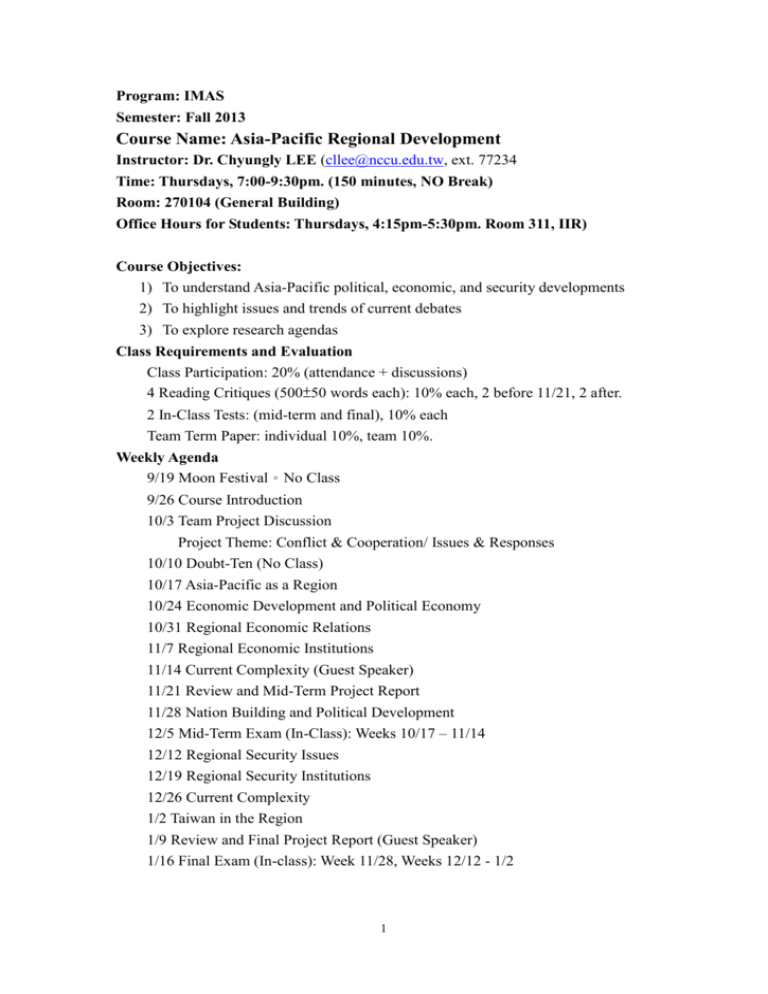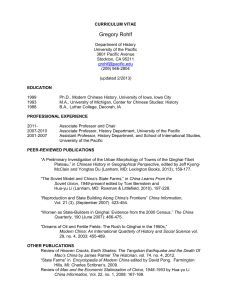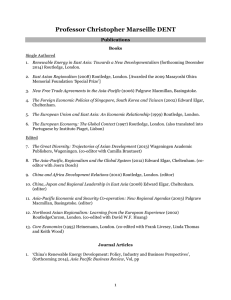2013 IMAS Syllabus - National Chengchi University
advertisement

Program: IMAS Semester: Fall 2013 Course Name: Asia-Pacific Regional Development Instructor: Dr. Chyungly LEE (cllee@nccu.edu.tw, ext. 77234 Time: Thursdays, 7:00-9:30pm. (150 minutes, NO Break) Room: 270104 (General Building) Office Hours for Students: Thursdays, 4:15pm-5:30pm. Room 311, IIR) Course Objectives: 1) To understand Asia-Pacific political, economic, and security developments 2) To highlight issues and trends of current debates 3) To explore research agendas Class Requirements and Evaluation Class Participation: 20% (attendance + discussions) 4 Reading Critiques (500±50 words each): 10% each, 2 before 11/21, 2 after. 2 In-Class Tests: (mid-term and final), 10% each Team Term Paper: individual 10%, team 10%. Weekly Agenda 9/19 Moon Festival。No Class 9/26 Course Introduction 10/3 Team Project Discussion Project Theme: Conflict & Cooperation/ Issues & Responses 10/10 Doubt-Ten (No Class) 10/17 Asia-Pacific as a Region 10/24 Economic Development and Political Economy 10/31 Regional Economic Relations 11/7 Regional Economic Institutions 11/14 Current Complexity (Guest Speaker) 11/21 Review and Mid-Term Project Report 11/28 Nation Building and Political Development 12/5 Mid-Term Exam (In-Class): Weeks 10/17 – 11/14 12/12 Regional Security Issues 12/19 Regional Security Institutions 12/26 Current Complexity 1/2 Taiwan in the Region 1/9 Review and Final Project Report (Guest Speaker) 1/16 Final Exam (In-class): Week 11/28, Weeks 12/12 - 1/2 1 Reading Assignments: (Due before Class) 10/3 Methodology & Analytical Framework 1. Amitav Acharya, International Relations and Area Studies: Towards a New Synthesis? (Singapore: IDSS working paper No. 2) www.rsis.edu.sg/publications/SSIS/SSIS002.pdf 2. Rick Fawn, “Regions and Their Study: where from, what for and where to?” Review of International Studies, 35, pp.5-34 3. Raimo Vayrynen, “Regionalism: Old and New,” International Studies Review, vol. 5, no. 1 (March 2003), pp. 25-51 10/17 Asia-Pacific as a Region 1. Das Dilip, “Structured Regionalism in the Asia-Pacific: Slow But Sure Progress”, Asia Pacific Viewpoint, Aug. 2004, Vol. 45, Issues 2, p.217-233. 2. Jim Rolfe, “A Complex of Structure: Functional Diversity, Regional Consolidation, and Community Development in the Asia-Pacific”, Asian Affairs: An American Review. 2007, Vol. 33, Issue 4, pp.217-234. 3. Yasumasa Komori, “Regional Governance in East Asia and the Asia-Pacific”, East Asia: An International Quarterly. Winter 2009, Vol. 26, Issue 4, pp.321-341. 4. Camilleri, Joseph A. Regionalism in the New Asia-Pacific Order (Edward Elagar Publishing, 2003) pp. 28-54. (zerox) 5. T.J. Pempel, “Introduction: Emerging Webs of Regional Connectedness,” in T. J. Pempel ed. Remapping East Asia: The Construction of a Region (Ithaca: Cornell University Press, 2005), pp.1-28. (zerox) 10/24 Economic Development and Political Economy 1. Stephan Haggard, “Institutions and Growth in East Asia”, Comparative International Development, Winter 2004, Vol. 38, No.4, pp. 53-81. 2. Joseph E. Stiglitz, “Some Lessons From the East Asian Miracle”. The World Bank Research Observer, Vol. 11, No. 2 (August 1996), pp. 151-77. 3. Richard Stubbs, “What Ever Happened to the East Asian Developmental States? Pacific Review. March 2009, Vol. 22, Issue 1, pp.1-22. 4. Shigeko Hayashi, “The Developmental State in the Era of Globalization: Beyond the Northeast Asian Model of Political Economy”, Pacific Review. March 2010, Vol. 23, Issue 1, pp. 45-69. 2 10/31 Regional Economic Relations 1. Terutomo Ozawa, “Pax Americana-Led Catch-Up, Flying-Geese Styles: Regionalized Endogenous Growth in East Asia”, Asian Economic Cooperation in the New Millennium: China’s Economic Presence, edited by Calla Wiemer and Heping Cao, (Singapore: World Scientific Publishing, 2004, pp. 153-174. 2. Dennis Tachiki, “Between Foreign Direct Investment and Regionalism: The Role of Japanese Production Network”, in Pempel ed. Remapping East Asia: The Construction of a Region (Ithaca: Cornell University Press, 2005), pp. 149-169. (zerox) 3. Prema-chandra Athukorala, “Production Networks and Trade Patterns in East Asia: Regionalization or Globalization?”, Asian Economic Papers 10:1, 2011. pp. 65-95. 11/7 Regional Economic Institutions 1. John McKay, “APEC: Successes Weaknesses and Future Prospects”, Southeast Asian Affairs 2002, pp. 42-53. 2. Dominique and Caouette and Denis Cote, “Ripe for A New Asian Multilateralism? ASEAN and Contemporary Regional Dynamics”, European Journal of East Asian Studies, March 2011, Vol. 10, Issue 1, pp. 5-36. 3. Siow Yue Chia, “The Emerging Regional Economic Integration Architecture in East Asia”, Asian Economic Papers 12:1, 2013. pp. 1-37 11/14 Current Complexity 1. Heribert Dieter, “Changing Patterns of Regional Governance: from Security to Political Economy?”, Pacific Review March 2009, Vol. 22, No. 1, pp. 73-90. 2. Christopher Dent, “Free Trade Agreements in the Asia-Pacific a Decade on: Evaluating the Past, Looking to the Future”, International Relations of the Asia-Pacific, May 2010, Vol.10, Issue 2, pp. 201-245. 3. Ann Capling and John Ravenhill, “Multilateralising Regionalism: What Role for the Trans-Pacific Partnership Agreement?”, Pacific Review. Dec. 2011, Vol. 24, No. 5, pp.553-575. 11/21 Review and Project Reports 11/28 (or 12/5) Mid-Term Exam. (week 10/17-11/21) 3 12/5 (or 11/28) Nation-Building and Political Development 1. Mark Berger, “Decolonisation, Modernisation and Nation-Building: Political Development Theory and the Appeal of Communism in Southeast Asia, 1945-1975”, Journal of Southeast Asian Studies, Vol. 34, Issue 3, October 2003, pp.421-448. 2. Franci Kok Wah Loh, “Procedural Democracy, Participatory Democracy and Regional Networking: the Multi-Terrain Struggle for Democracy in Southeast Asia,” Inter-Asia Cultural Studies, Vol. 9, No. 1, 2008, pp. 127-141. 3. Yun-Han Chu, Larry Diamond, Andrew J. Nathan and Doh Chull Shin, “Asia’s Challenged Democracies”, The Washington Quarterly, 32:1, Jun. 2009, pp. 143-157. 4. Aurel Croissant and David Kuehn, “Patterns of Civilian Control of the Military in East Asia’s New Democracies”, Journal of East Asian Studies 9 (2009), pp.187-217. 12/12 Regional Security Issues 1. Jae Jeok Park, “The US-Led Alliances in the Asia-Pacific Hedge Against Potential Threats or an Undesirable Multilateral Security Order?”, The Pacific Review, Vol. 24, No. 2, May 2011, pp. 137-158. 2. Aileen San Pablo-Baviera, “The China Factor in US Alliances in East Asia and the Asia Pacific”, Australian Journal of International Affairs, Vol. 57, No. 2, July 2003, pp.339-352. 3. Christopher Jasparro and Janathan Taylor, “Climate Change and Regional Vulnerability to Transnational Security Threats in Southeast Asia”, Geopolitics, Vol. 13, 2008, pp. 232-256. 4. Suk Kyoon Kim, “Maritime Security Initiatives in East Asia: Assessment and the Way Forward”, Ocean Development and International Law, Vol. 44, 2011, pp. 227-244. 12/19 Regional Security Institutions 1. Barry Desker, “New Security Dimensions in the Asia-Pacific”, Asia-Pacific Review, May 2008, Vol. 15, Issues 1, pp. 56-75 2. Mark Rolls, “Centrality and Continuity: ASEAN and Regional Security Since 1967”, East Asia: An International Quarterly, June 2012, Vol. 29, Issue 2, pp.127-139. 3. Jurgen Haacke, “The ASEAN Regional Forum: from Dialogue to Practical Security Cooperation?” Cambridge Review of International Affairs, Sep. 2009, Vol. 22, Issue 3, pp.427-449. 4 4. Ralf Emmers, Joseph Chinyong Liow, and See Seng Tan, “The East Asia Summit and the Regional Security Architecture”, Maryland Series in Contemporary Asian Studies, No. 3, 2010. 12/26 Current Complexity 1. Martin Jones, “Security and Democracy: the ASEAN Charter and the Dilemmas of Regionalism in Southeast Asia”, International Affairs 84:4 (2008) pp.735-756. 2. Chris Rahman and Martin Tsamenyi, “Strategic Perspective on Security and Navy Issues in the South China Sea”, Ocean Development & International Law, 41: 315-333, 2010. 3. David Rosenberg and Christopher Chung, “Maritime Security in the South China Sea: Coordinating Coastal and User State Priority”, Ocean Development & International Law, 39: 51-68, 2008. 1/2 Taiwan in the Region 1. Min-Hua Chiang and Bernard Gerbier, “Taiwan and the Transformation of Asia-USA Economic Relationship: From the Triangular Trading Bloc to Four Corner Structure”, La Chronique des Ameriques, No. 19, November 2008 2. Christopher M. Dent, “Taiwan and the New Regional Political Economy of East Asia”, The China Quarterly, vol. 182, 2005, pp.385-406 3. Jiann-Chyuan Wang, “The Strategies Adopted by Taiwan in Response to the Global Financial Crisis, and Taiwan’s Role in Asia-Pacific Economic Integration”, Japan and the World Economy, Vol. 22, 2010, pp.254-263. 4. Wu Xinbo, “The Taiwan Issue and U.S.-Asia/Pacific Security Strategy”, American Foreign Policy Interests, Vol. 24, No. 3, 2002, pp. 231-235. 5. Edward Friedman, “China’s Ambitions, America’s Interests, Taiwan’s Destiny, and Asia’s Future”, Asian Survey, Mar/Apr 2013, Vol. 53 Issue 2, pp.225-244. 1/9 Review and Final Project Report In-class conference, Guest Commentator 1/16 Final Exam (In-Class): Weeks 12/5-1/9) 5







